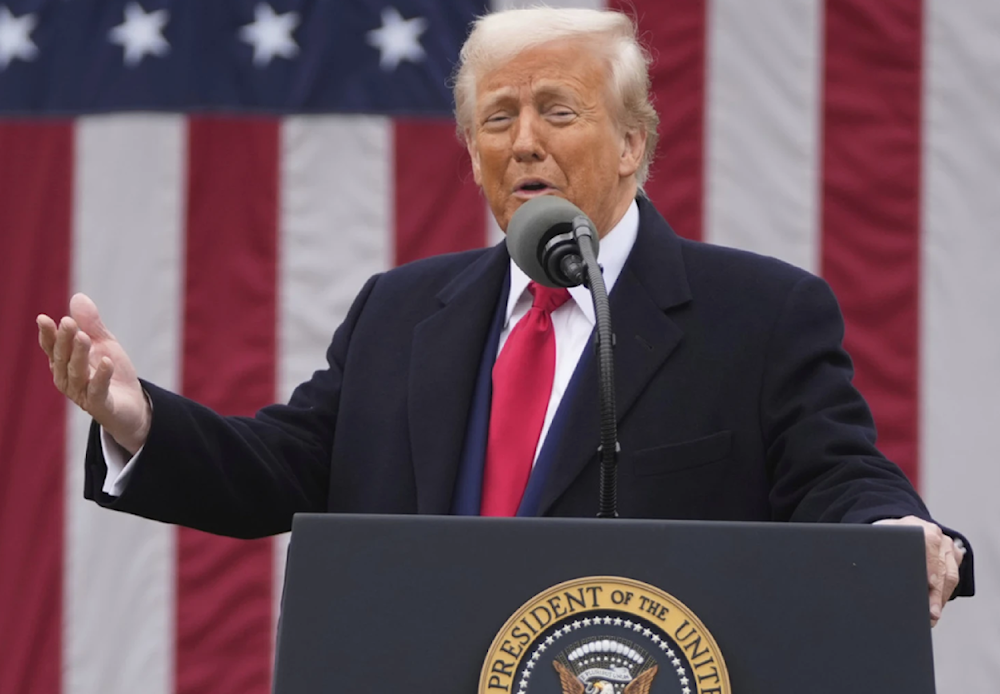US dollar falls 1% vs euro, US stocks drop as Trump unveils tariffs
Major US indexes fell after President Trump's tariff announcement, with the SPDR S&P 500 ETF Trust (SPY) dropping about 2.2%.
-

President Donald Trump speaks during an event to announce new tariffs in the Rose Garden at the White House, Wednesday, April 2, 2025, in Washington. (AP)
The US dollar plummeted one percent against the euro on Wednesday, as President Donald Trump said that he would sign an order imposing retaliatory tariffs on US trading partners.
The dollar also fell against other important currencies, such as the British pound sterling and the Swiss franc.
"For traders and investors, today represents a day of huge uncertainty as we weigh up the potential for retaliatory tariffs and a tit-for-tat trade war," said Joshua Mahony, analyst at traders Scope Markets.
Global equities have been hit hard leading up to Trump's announcement, with allies and competitors alike in the crosshairs after what he said are years of "ripping off" the United States.
US stocks drop
US stocks fell in after-hours trading as President Donald Trump unveiled the sweeping tariffs of a minimum 10%, but even higher for some countries.
The SPDR S&P 500 ETF Trust (SPY), which tracks the S&P 500, lost about 2%. The Invesco QQQ ETF, which corresponds to the Nasdaq-100 Index, shed 3.3%. The SPDR Dow Jones Industrial Average ETF Trust (DIA) lost 1%.
Shares of companies that are big importers were hit Wednesday evening. Nike lost 6%. General Motors tumbled 3%. Shares of hard-hit stocks over the past month as tariff fears swirled continued falling. Nvidia and Tesla were each off about 3%.
The White House unveiled a baseline tariff rate of 10% on all countries that goes into effect April 5. Even bigger duties will be charged against countries in the coming days that levy higher rates on the US.
“We will charge them approximately half of what they are and have been charging us,” said Trump in a press conference from the White House Rose Garden. “So, the tariffs will be not a full reciprocal.”
That halved figure includes “the combined rate of all their tariffs, non-monetary barriers and other forms of cheating,” he said.
What’s likely scaring traders is that these rates will end up being much higher than expected for many nations. For example, the effective tariff rate for China will now be 54%.
Wednesday saw further volatility roil markets as tensions ran high ahead of Trump’s announcement, but stocks ultimately ended the session in the green on hopes that the tariff would be less stringent than feared. The S&P 500 closed 0.7% higher. The Dow Jones Industrial Average added 235 points, or 0.6%, while the tech-heavy Nasdaq Composite added 0.9%.
The broad-based S&P 500 was down for five out of the past six weeks because of the heightened uncertainty caused by Trump’s varied tariff announcements, which have been rolling out since February. Ongoing tensions with key US global trading partners have started to show up in some sluggish economic data, which further pressured stocks by heightening recession fears.
The S&P 500 crossed briefly again into correction territory on Monday, meaning a 10% slide from its last high, and saw its worst monthly percentage drop since December 2022 in March. The index first slipped into a correction in mid-March.
Shares of iPhone maker Apple also slipped nearly 5% in Wednesday’s after-hours trading.
Gold futures price jump
Meanwhile, the gold futures price jumped US$20.20 or 0.6% to US$3,166.20 an ounce on Wednesday, supported by safe-haven demand as markets braced for US President Donald Trump's latest tariff plans later in the day. Spot gold was trading near US$3,127 at the US close.
The gold futures price jumped US$20.20 or 0.6% to US$3,166.20 an ounce on Wednesday, supported by safe-haven demand as markets braced for US President Donald Trump's latest tariff plans later in the day. Spot gold was trading near US$3,127 at the US close. #ausecon #auspol
— CommSec (@CommSec) April 2, 2025

 4 Min Read
4 Min Read








